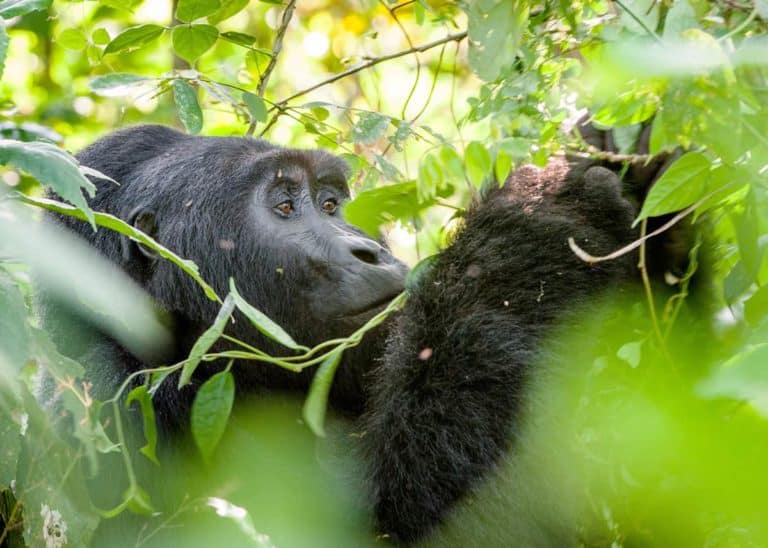16 Biggest African Antelopes: Largest Species by Weight
What is the largest antelope in Africa? In this post, you’ll learn about the biggest antelopes in Africa, sorted by their average weight. Antelopes range in size from just 6 pounds to over 2200 pounds. There are 91 species of antelopes, most of which reside in Africa.
The largest antelope in Africa is the Giant Eland, weighing up to 2,200 pounds (1000 kilograms)! In contrast, the smallest antelope, the Royal Antelope, is smaller than the average house cat.
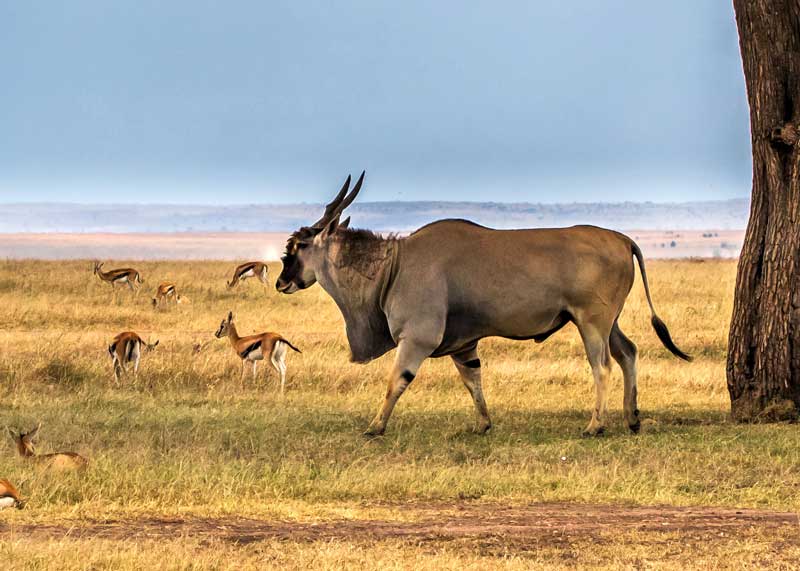
There are lots of differences between the various species, including their size, physical features, behaviors, and habitats. Some antelopes are pretty quirky!
For information on some of the 16 largest antelopes in Africa, please keep reading.
Largest African Antelope: By Weight
Here’s the summary of the largest African antelopes by weight. Weights are shown at the high end for each species (or subspecies).
- Giant Eland: 2,200 pounds (1,000 kilograms)
- Common Eland: 2,077 pounds (942 kilograms)
- Bongo: 893 pounds (405 kilograms)
- Greater Kudu: 694 pounds (315 kilograms)
- Roan Antelope: 661 pounds (300 kilograms)
- Blue Wildebeest (Brindled Gnu): 640 pounds (290 kilograms)
- Waterbuck: 578 pounds (262 kilograms)
- Gemsbok: 530 pounds (240 kilograms)
- Sable Antelope: 518 pounds (235 kilograms)
- Scimitar Oryx: 460 pounds (210 kilograms)
- Hartebeest: 440 pounds (200 kilograms)
- Black Wildebeest (White-tailed Gnu): 340 pounds (154 kilograms)
- Nyala: 309 pounds (140 Kilograms)
- Bushbuck: 176 pounds (80 kilograms)
- Impala: 168 pounds (76 kilograms)
- Dama Gazelle: 165 pounds (75 kilograms)
Guide to the 16 Largest African Antelopes
Let’s look at some of the 16 largest African Antelopes. They are in order according to weight, starting with the heaviest.
1. Giant Eland
- Common Name: Giant Eland, or Lord Derby Eland
- Latin Name: Taurotragus Derbianus
- Habitat: Savannah or open forested areas in parts of Central and Western Africa
- Weight: Males: 880-2,200 pounds (400-1,000 kilograms), Females: 660-1,320 pounds (300-600 kilograms)
- Height: 4.3-5.9 feet (130-180 centimeters) at the shoulder
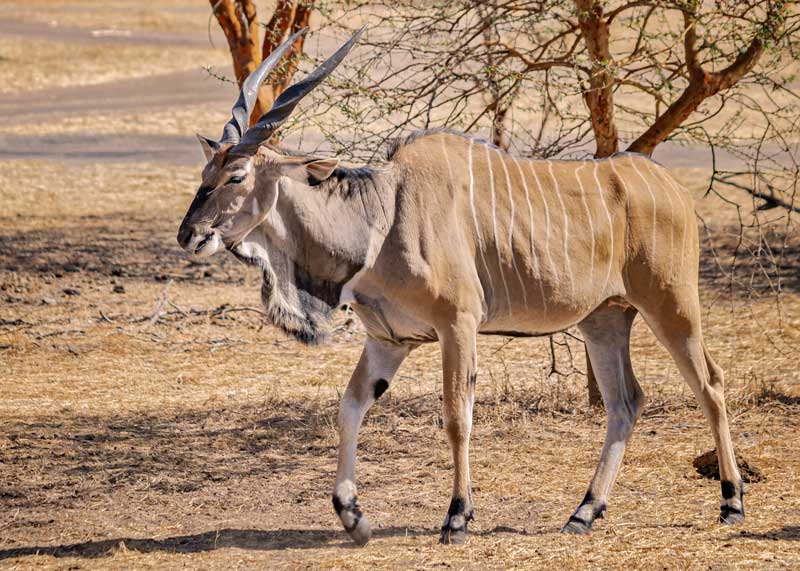
The Giant Eland is the largest of the antelopes. While it’s true that is huge (weighing up to 2,200 pounds/1,000 kilograms), it actually got its name from its large horns.
These tightly spiraled horns grow upward in a v-shape, with males having horns up to 4 feet long (122 centimeters). Females also grow horns, but they only grow to about 2.2 feet (67 centimeters).
Giant Elands are chestnut brown, with a line of black hair that runs down their neck to the middle of their back. There are 8 to 12 vertical white stripes on their torso.
An identifying feature is the large dewlap (a swaying large flap of extra skin) under their neck. The dewlap is larger in males than in females.
There are two subspecies of the Giant Eland.
- Eastern Giant Eland is considered vulnerable.
- Western Giant Eland is listed as Critically Endangered.
Threats include overhunting, loss of habitat due to human settlement, and wars and civil conflicts that disturb their activities.
They are slightly larger than the Common Eland, with longer legs, and brighter black and white markings on their legs.
2. Common Eland
- Common Name: Common Eland, Southern Eland, Eland Antelope
- Latin Name: Taurotragus Oryx
- Habitat: Savannah and plains in Eastern and Southern Africa
- Weight: Up to 2,077 pounds (942 kilograms), with an average of 1,100-1,300 pounds (500-600 kilograms) for males, and 750-981 pounds (340-445 kilograms) for females
- Height: 5 feet (160 centimeters) at the shoulder, females are 8 inches (20 centimeters) shorter
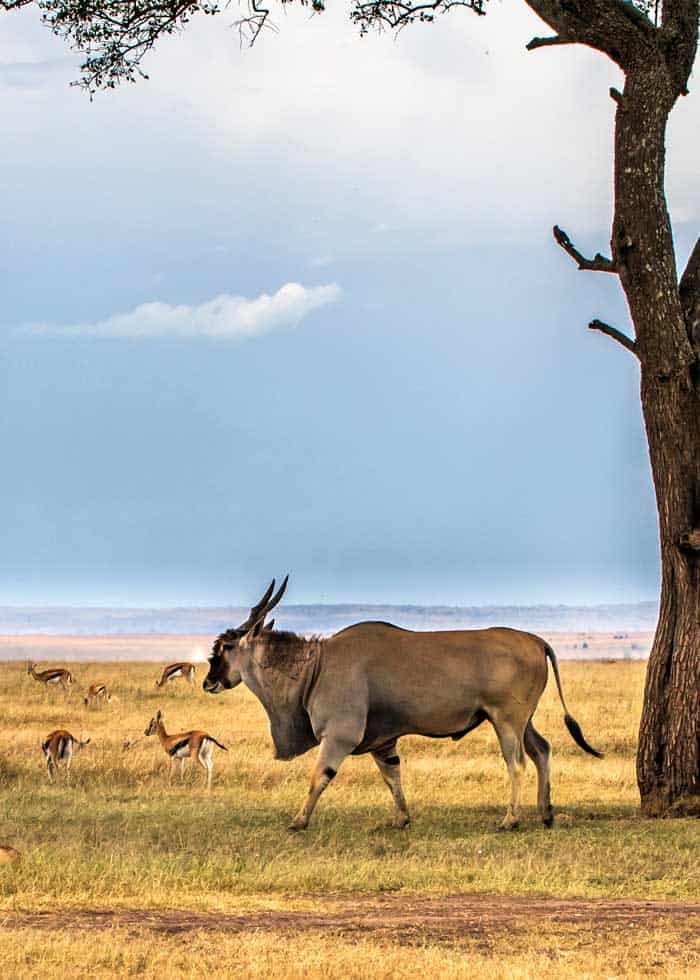
As indicated by its name, the Common Eland is more common and less giant than the Giant Eland. You can find them in herds throughout the southern half of Africa. That being said, the Common Eland’s population is decreasing.
Compared to the Giant Eland, which can achieve speeds of 43.5 miles (70 kilometers) an hour, the Common Eland is relatively slow. It can reach a peak speed of 25 miles (40 kilometers) per hour. However, even that tires them out quickly.
But they sure can jump! From a standing start, adult Elands can jump 8 feet (2.5 meters), and juveniles can jump even further (nearly 10 feet/ 3 meters).
If you ever get the chance to get close to a herd of Common Eland, you will hear a unique clicking noise. It’s believed this is caused by the sides of their hooves separating and clicking back together as they walk. It can be heard from quite a distance, and may even serve as some form of communication.
Because of their docile nature and their ability to survive on limited water, the Common Eland has become domesticated in parts of Africa.
Compared to cow’s milk, Eland milk has a much higher fat count. It can also be stored for a much longer time- up to eight months if prepared properly. However, they need lots of grazing land, and really high fences.
3. Bongo
- Common Name: Bongo
- Latin Name: Tragelaphus Eurycerus
- Habitat: Forested areas in Central and Western Africa
- Weight: 485-893 pounds (220-405 kilograms) for males, 331-518 pounds (150-235 kilograms) for females
- Height: 3.6-4.3 feet (1.1-1.3 meters) at the shoulder
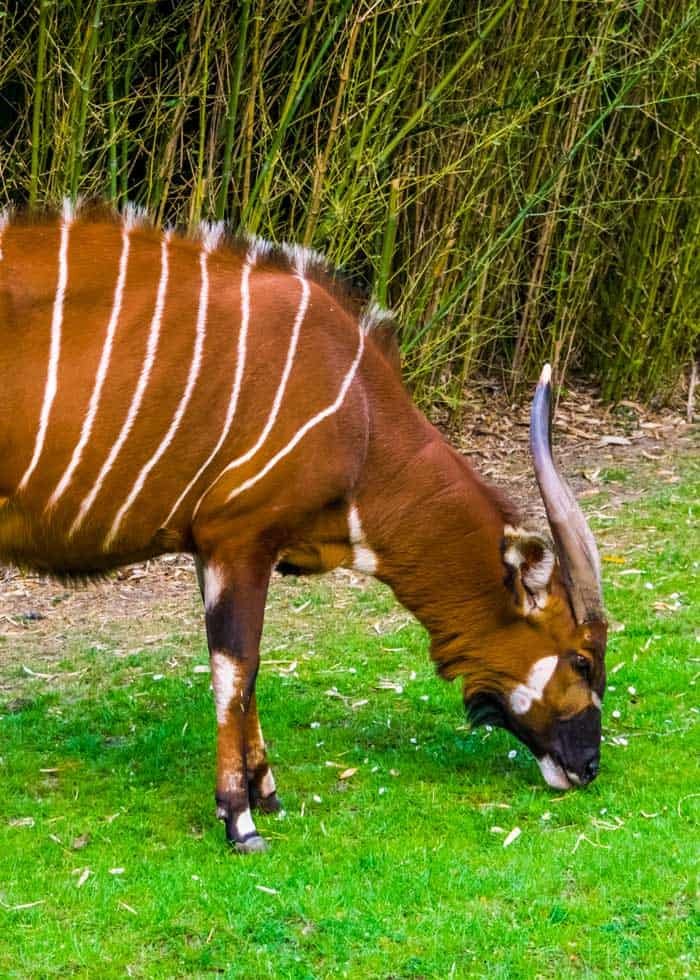
Bongos are the third-largest antelope. They are chestnut brown, with 10-15 vertical white stripes along their torsos. Their coloring helps them to stay camouflaged in their forest home.
If you are a fan of symmetry, don’t look too closely, as the number of stripes on one side is rarely the same as the number of stripes on the other side.
An interesting fact about the diet of the Bongo is that they love salt. They have been known to eat the charcoal remains of trees that have been hit by lightning, as they provide a rich source of salt and minerals.
There are two subspecies of the Bongo. The Lowland or Western Bongo, and the Mountain or Eastern Bongo. Both are facing population decline due to logging and poaching.
The Western Bongo is Near Threatened, while the Eastern Bongo is Critically Endangered (with fewer than 100 individuals left in the wild).
4. Greater Kudu
- Common Name: Greater Kudo, or Koodoo
- Latin Name: Tragelaphus Strepsiceros
- Habitat: Woodlands throughout Western and Southern Africa
- Weight: Up to 694 pounds (315 kilograms), with an average of 420-600 pounds (190-270 kilograms) for males, and 260-460 pounds (120-210 kilograms) for females
- Height: Males are 63 inches (160 centimeters) at the shoulder. Females are shorter, 39 inches (100 centimeters) at the shoulder.
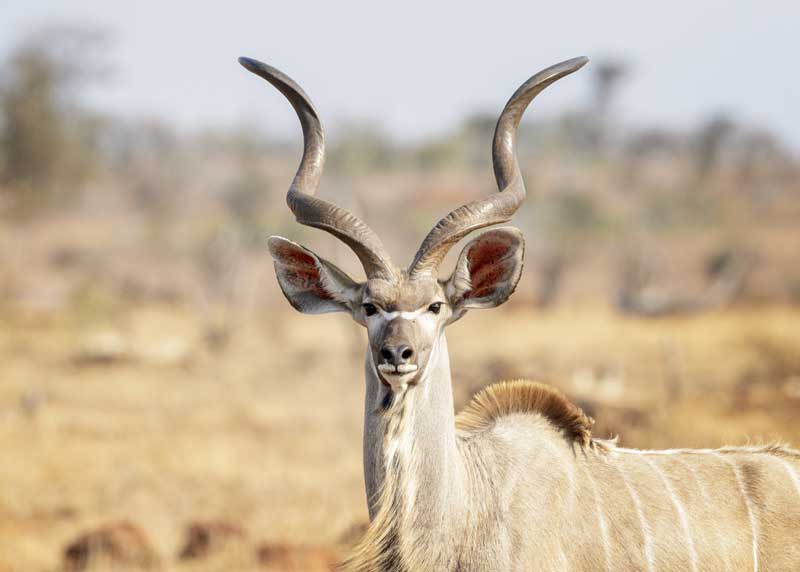
A male Greater Kudu will grow a beard and horns, whereas the female will not. They are also much more vocal than the females. Some of the sounds they make are humming, low grunts, clucks, and gasping.
They are herbivores. Their favorite foods include leaves, grass, tubers, roots, and shoots. They can also be found snacking away on fruits, including tangerines and oranges.
They are not territorial, so herds will often live in overlapping areas. Females live with other females and their young. Usually, each group will have 6-10 Kudus, but the group can have as many as 20 individuals.
Males may form bachelor groups, but more often than not they live alone (unless it’s the mating season).
Learn more about all 74 African antelope species.
5. Roan Antelope
- Common Name: Roan Antelope
- Latin Name: Hippotragus Equinus
- Habitat: Savannahs, woodlands, and grasslands in Western, Central, and Southern Africa
- Weight: 534-661 pounds (242-300 kilograms) for males, 492-617 pounds (223-280 kilograms) for females
- Height: 51-63 inches (130-160 centimeters) at the shoulder
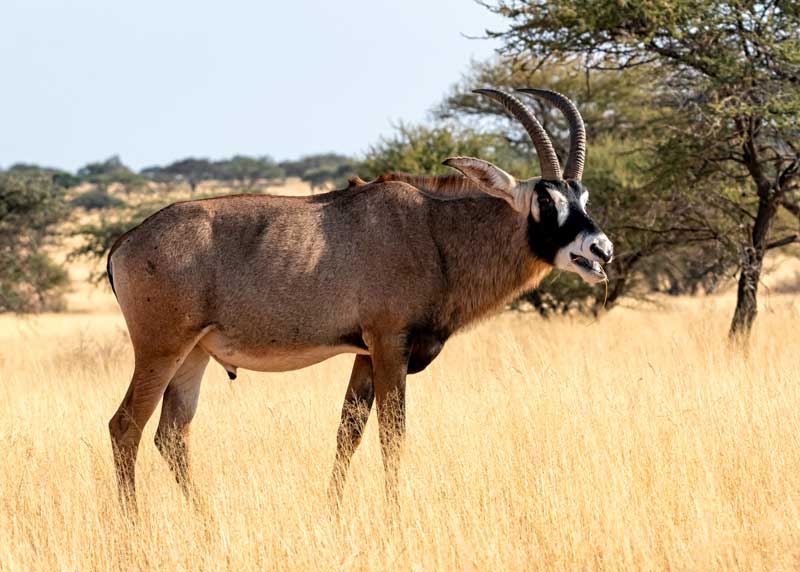
The name roan comes from their coloring, a reddish-brown. Their faces are black, with white patches around their eyes and mouth.
As their range overlaps with the Sable Antelope, they are easy to mix up at first glance. A way to tell them apart is that the male Sable Antelopes are darker (more of a brownish-black) once they reach maturity.
Roans make many different noises. When they are distressed or injured, they may make a hissing noise. They also make a high-pitched whistling sound.
And unlike other antelopes that bark when in danger, Roan Antelopes snort.
6. Blue Wildebeest (Gnu)
- Common Name: Blue wildebeest. Also known as brindled gnu, common wildebeest, and white-bearded gnu.
- Latin Name: Connochaetes taurinus (Blue wildebeest)
- Habitat: Grassland throughout southern and eastern Africa
- Weight: 640 lbs (290 kg) for males, 570 (260 kg) for females
- Height: 55 inches (140 centimeters) at the shoulder
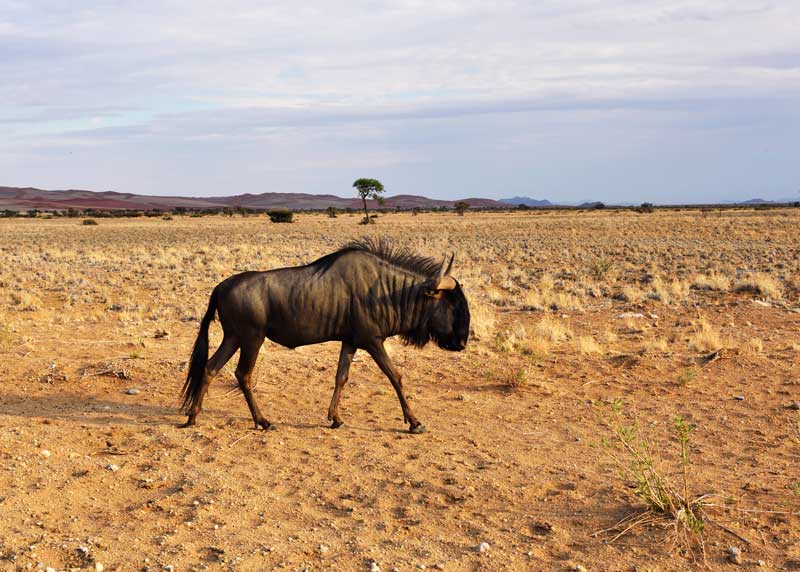
The blue wildebeest gets it name from the silvery-blue sheen on their coat, according to The Behavior Guide to African Mammals. Its alternative name “gnu” comes from the Khoikhoi people.
While they often have a blue sheen on their coats, it can also appear light gray, even more brown than blue.
The blue wildebeest population stands at around 1.5 million individuals. They typically produce a single calf.
The blue wildebeest is prey to leopards, lions, hyenas, and African wild dogs.
The other species of wildebeest is also on this list. See #12 for more about the Black wildebeest (White-tailed gnu).
7. Waterbuck
- Common Name: Waterbuck
- Latin Name: Kobus Ellipsiprymnus
- Habitat: Grassland throughout Sub-Saharan Africa
- Weight: 437-578 pounds (198-262 kilograms) for males, 355-472 pounds (161-214 kilograms) for females
- Height: 50 inches (127 centimeters) at the shoulder for males, 47 inches (119 centimeters) for females
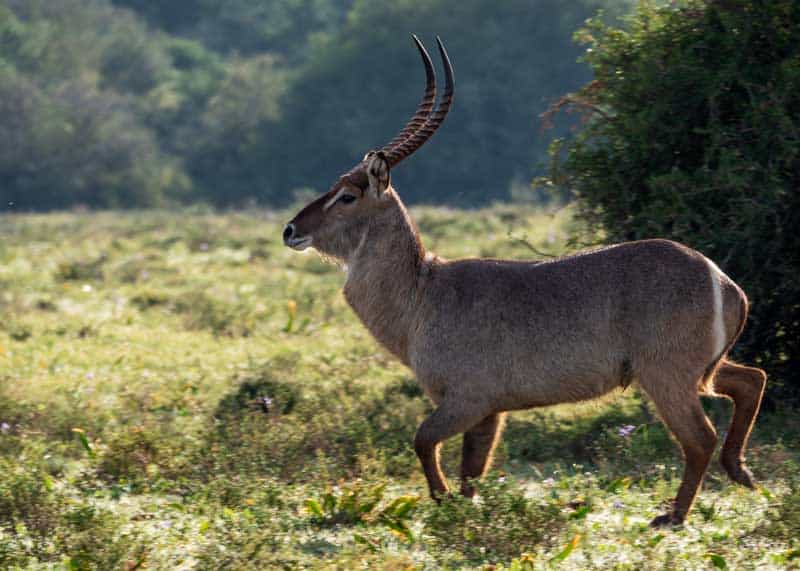
Fittingly named, the Waterbuck are often found near sources of water. That is because, unlike some of their antelope relatives, Waterbucks do not handle dehydration well.
They can also enter into the water as a form of defense. Big cats like lions and leopards do not like getting wet.
A neat feature of the Waterbuck is that they have a lot of long hair on their necks. It’s certainly not to keep them warm, as they live where it is hot. Rather, these hairs are hollow and buoyant (they float).
So this “hairy scarf” helps them to keep their head above water. Waterbucks also secrete oils, which causes the hair to repel water. This oil has a strong and foul odor, so it may serve to repel more than just water.
There are currently 13 recognized subspecies of Waterbucks. (Before 1971, they had categorized the Waterbuck into 37 subspecies). The main differences between the subspecies are the coloring of their coat and the country/location where they are found.
8. Gemsbok
- Common Name: Gemsbok, Gemsbuck, or South African Oryx
- Latin Name: Oryx Gazella
- Habitat: Arid regions of Southern Africa
- Weight: 400-530 pounds (180-240 kilograms) for the male, 220-460 pounds (100-210 kilograms) for the female
- Height: 3.9 feet (1.2 meters) at the shoulder
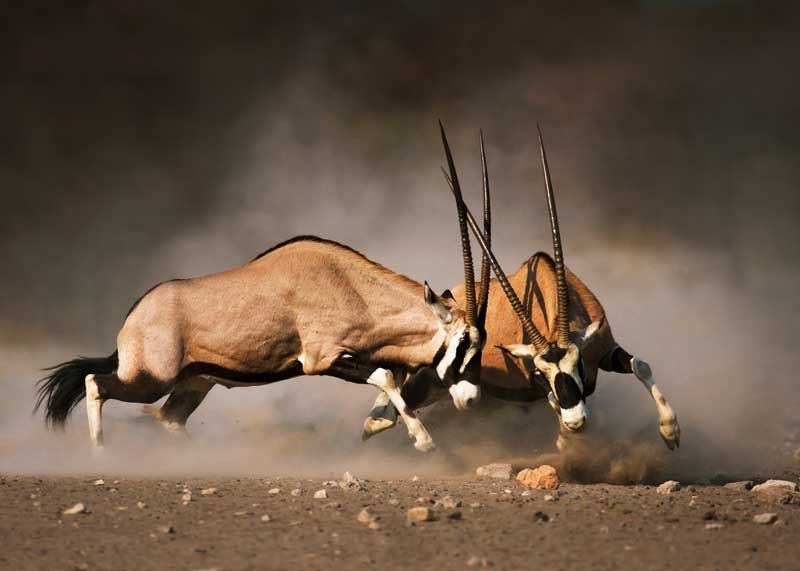
Gemsboks are tan or a light brownish-grey in color. They have distinctive black stripes on their faces and legs, and white “socks.”
There are a few Gemsbok with a rare color morph (visual difference). They are called “Golden Oryx.” The markings that are normally black are muted and appear to be golden in color.
Gemsboks live in herds of 10-40 animals. The herd consists of mostly females, but also includes a dominant male and a few non-dominant males.
You can also find Gemsbok in North America. A number of animals were brought to New Mexico in 1969. Between that year and 1977, ninety-three Gemsboks were introduced to the wild. Without lions and cheetahs around, the population is thriving, with an estimated population of 3,000.
9. Sable Antelope
- Common Name: Sable Antelope
- Latin Name: Hippotragus Niger
- Habitat: Wooded Savannah in Eastern and Southern Africa
- Weight: 518 pounds (235 kilograms) for males. 490 pounds (220 kilograms) for females
- Height: 45-55 inches (117-140 centimeters) at the shoulder
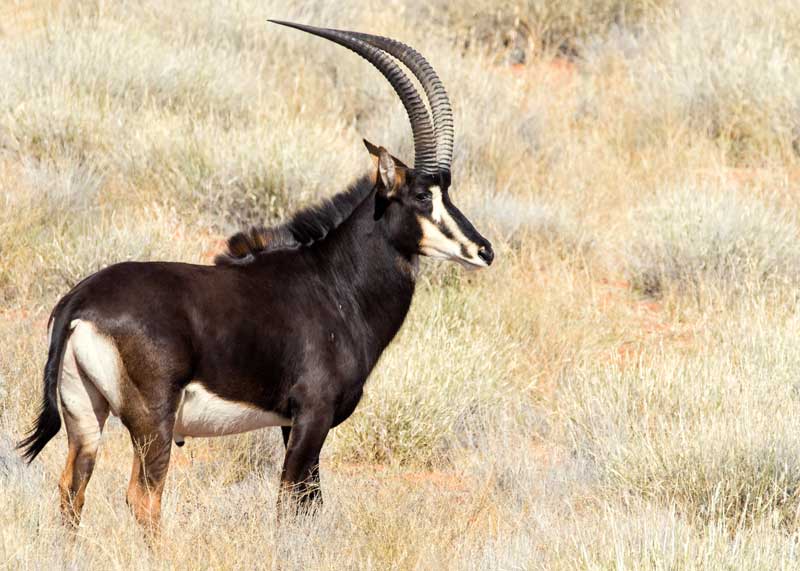
With a thick neck and tough skin, the Sable Antelope is robust. The female Sable Antelope is chestnut-brown. The male starts out brown, but darkens as time passes. By the time a male is 3 years old, its coat will be black. Both males and females grow an upright mane on their neck, as well as on their throat. Their tails have a tuft at the end. Also, both sexes have horns.
There are four subspecies of Sable Antelopes: The Southern Sable Antelope (also know as the Black Sable Antelope, the Common Sable Antelope, the Matsetsi Sable Antelope, or the South Zambian Sable Antelope), the Giant Sable Antelope (also known as the Royal Sable Antelope), the Zambian Sable Antelope (also known as the West Zambian Sable Antelope, or the West Tanzanian Sable Antelope), and the Eastern Sable Antelope (also known as the Shimba Sable Antelope).
The Giant Sable Antelope is of particular interest as it is both the largest and the rarest of the Sable Antelopes. So rare in fact that it is on the Critically Endangered list. It is only found in Angola.
At one point it was wondered if any of this species had survived the Angolan Civil War. But in 2004 a group using hidden cameras was able to obtain photographic evidence of one of the last surviving herds. The Giant Sable Antelope is the National Symbol of Angola.
10. Scimitar Oryx
- Common Name: Scimitar Oryx, Scimitar-Horned Orys, Sahara Oryx
- Latin Name: Oryx Dammah
- Habitat: Extinct in the wild, but formerly lived in deserts in Northern Africa
- Weight: 310-460 pounds (140-210 kilograms) for males, 201-309 pounds (91-140 kilograms) for females
- Height: 3.3 feet (1 meter) at the shoulder
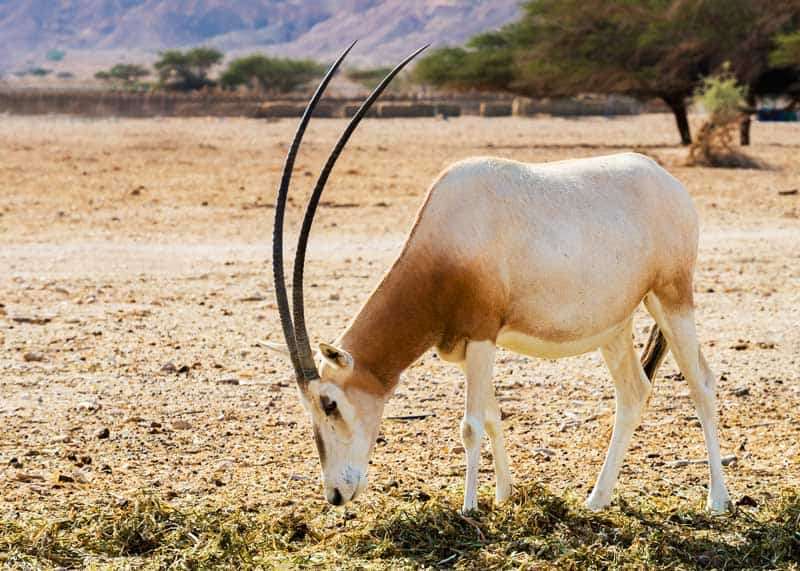
Baby Scimitar Oryx are born yellow, but their coats gradually change color between 3-12 months of age. Adults are white, with a reddish-brown chest, and black markings on their faces.
Scimitar Oryx has a long history. They were domesticated in Ancient Egypt. Later on, wealthy people in Rome also bred them. Interestingly, the myth of the unicorn may have begun with a sighting of a Scimitar Oryx with a broken horn.
Considered extinct in the wild, there are a few breeding programs in place with animals in captivity with the hopes of reintroducing them to the wild.
11. Hartebeest
- Common Name: Hartebeest, or Kongoni
- Latin Name: Alcelaphus Buselaphus
- Habitat: Savannahs and grasslands throughout Africa, depending on the subspecies
- Weight: 220-440 pounds (100-200 kilograms)
- Height: 3.3 feet (1 meter) at the shoulder
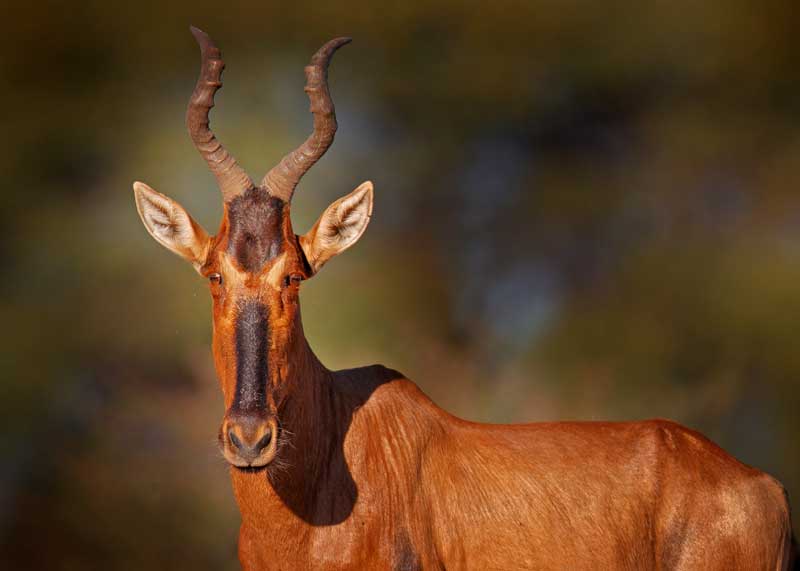
Hartebeests are non-aggressive. They spend their days grazing on grass in large herds of 20 to 300 members. If there’s enough grass to graze, the herds may converge into even larger groups. In 1963, a gathering of 10,000 Hartebeests was recorded in Botswana!
They are very alert, making it hard for a lion or another predator to sneak up on them. When most of the herd is grazing, one Hartebeest will stay on the lookout.
Often, this individual will stand on a termite mound to be able to see further into the distance.
There are eight subspecies of the Hartebeest, one is completely extinct. Threats include habitat destruction, human settlement, hunting, and competition with livestock for food.
Hartebeest Subspecies and Threat Levels:
- Bubal Hartebeest: Extinct
- Red Hartebeest: Least Concern
- Coke’s Hartebeest: Least Concern
- Lelwel Hartebeest: Endangered
- Lichtenstein’s Hartebeest: Least Concern
- Western Hartebeest: Near Threatened
- Swayne’s Hartebeest: Endangered
- Tora Hartebeest: Critically Endangered
12. Black Wildebeest
- Common Name: Black wildebeest, white-tailed gnu
- Latin Name: Connochaetes gnou
- Habitat: Open plains and grasslands. They also inhabit the Karoo region of South Africa.
- Weight: 340 pounds (154 kilograms)
- Height: 48 inches (121 centimeters) for the male, 46 inches (116 centimeters) for the female
Black wildebeests are surprisingly fast runners, reaching speeds of 44 mph (70 km/h) . This is thanks to their fast-twitch muscle fibres, according to the Journal of Experimental Biology
The black wildebeest lives further south than the larger herds of blue wildebeest. While there are overlapping ranges, the blue wildebeest herds typically live in northern parts of South Africa, and further north.
As herbivores, the black wildbeest eat grasses almost exclusively. They divide their social groups into three defined herds: females, bachelors, and territorial bulls.
This is the smaller of two wildebeest species. See more about the much larger blue wildebeest above.
13. Nyala
- Common Name: Nyala or Lowland Nyala
- Latin Name: Tragelaphus Angasii
- Habitat: Dense woodlands and thickets in Southern Africa
- Weight: 216-309 pounds (98-140 Kilograms) for the male, 121-150 pounds (55-68 kilograms) for the female
- Height: 43 inches (110 centimeters) for the male, 36 inches (90 centimeters) for the female
Females and young male Nyala have distinct white vertical stripes on their torso. As males get older, these stripes become less distinguished and may disappear altogether. The males are also hairier and have horns, which the females do not have.
The Nyala have hairy glands on their feet, so they leave their scent wherever they walk.
Predators include lions, leopards, and wild dogs. When threatened, the female Nyalas will let out a high, sharp, dog-like bark to warn the others in its herd. Interestingly, they will also react to the warning calls given out by impalas, kudus, and baboons.
14. Bushbuck
- Common Name: Bushbuck
- Latin Name: Tragelaphus Scriptus
- Habitat: A wide range of habitats including rain forests, savannahs, bushveld, and woodland throughout Sub-Sarahan Africa
- Weight: 99-176 pounds (45-80 kilograms)
- Height: 35 inches (90 centimeters) at the shoulder
Bushbucks are the smallest of the spiral-horned antelopes. Unlike some of the other large antelope species, the Bushbuck is not a herd animal. Rather, they prefer to spend their days alone, or perhaps with a mate.
Bushbucks live in a wide range of habitats, from Savannahs to rainforests. They do not necessarily have to be close to a water source, as they can get most of their liquids from the food they eat and from the dew. Because of their versatility, there are estimated to be over a million wild Bushbucks living in Africa.
15. Impala
- Common Name: Impala
- Latin Name: Aepyceros Melampus
- Habitat: Woodland and bushland in Eastern and Southern Africa
- Weight: 88-168 pounds (40-76 kilograms)
- Height: 28-36 inches (70-92 centimeters) at the shoulder
There are two subspecies of Impalas. The first is the Common Impala. There is also a Black-Faced Impala, which is larger and darker. Unfortunately, the Black-Faced Impala is a vulnerable species, with fewer than 1,000 individuals still living in the wild.
The Impala is well known for its leap, or rather its combination of leaps. An able jumper, an Impala can reach heights of 9.8 feet (3 meters) in the air, and a distance of 33 feet (10 meters) in a single leap.
Another form of leaping is called stotting (a series of jumps where it lands on all fours and rebounds). To escape predators, the Impala will switch up its type of leap and also its direction.
A neat feature of the Impala is the arrangement of their teeth. On the front of their lower jaw are a series of teeth that form a “toothcomb,” perfect for grooming and getting rid of pesky parasites.
The Impala appears to be the only ungulate (mammal with hooves) to participate in allogrooming- meaning that they not only groom themselves, they also groom fellow Impalas.
Speaking of grooming, the Impala has a symbiotic relationship with the Oxpecker bird. A mostly woodland animal, the Impala will pick up lots of ticks. While it can reach some by itself, the Oxpecker will feast on the ticks that are harder to reach (such as those in the ears and eyelids).
The mating season (rut) of the Impala occurs for about three weeks at the end of the rainy season (typically in May).
After a gestation period of six or seven months, a single calf is born. After nursing for four to six months, young males are forced out and join bachelor herds. Female offspring may stay with the large all-female herd, consisting of up to 100 individuals.
16. Dama Gazelle
- Common Name: Dama Gazelle, Mhorr Gazelle, Addra Gazzelle
- Latin Name: Nanger Dama
- Habitat: Desert areas mainly in Chad and Sudan
- Weight: 77-165 pounds (35-75 kilograms)
- Height: 35-47 inches (90-120 centimeters) at the shoulder
With its incredibly long legs, the Dama Gazelle is the largest of the Gazelles. Unfortunately, they are critically endangered, with fewer than 500 of them remaining in the wild. This is due to changes in their habitat (desert getting drier), overgrazing by nearby domestic herds, and overhunting.
During the rainy season, the Dama Gazelle spends its time in the Sahara Desert. In the dry season, it moves out to the open bushland in search of food. They eat shrubs, herbs, desert grasses, and Acacia tree leaves. They will stand up on their hind legs to reach the higher leaves.
Learn about the difference between horns and antlers.
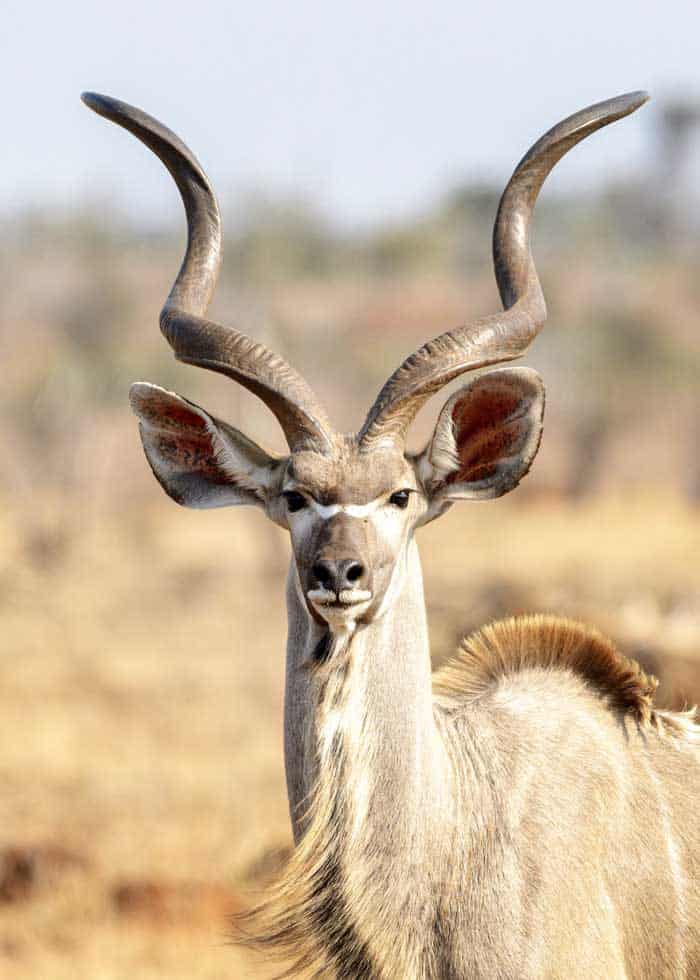
Here’s more about the 15 smallest antelopes in Africa. Antelopes are some of the fastest animals on the planet.
Your Turn:
Have you seen one of these majestic creatures in real life? What is your favorite large antelope fact? Tell me about your antelope experiences in the comments below.






